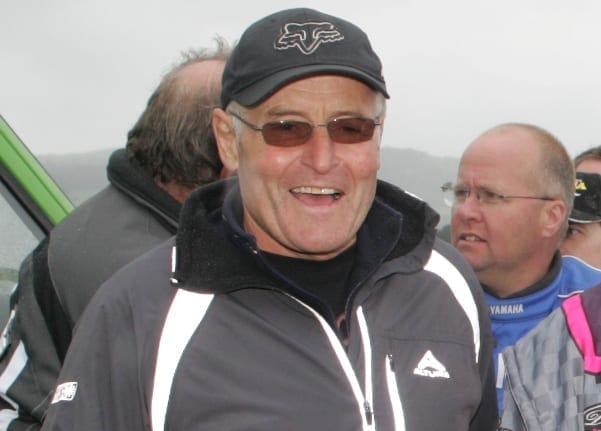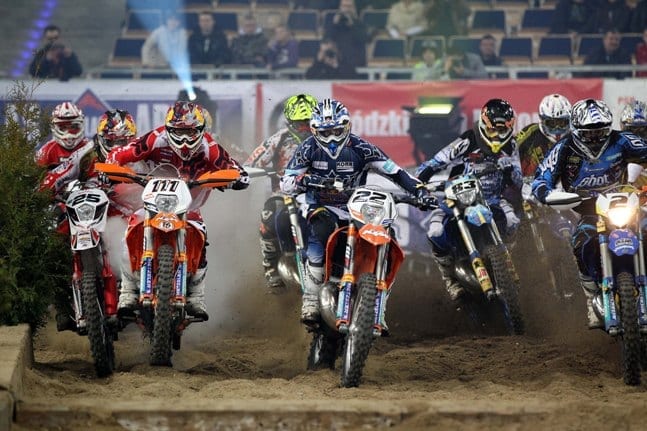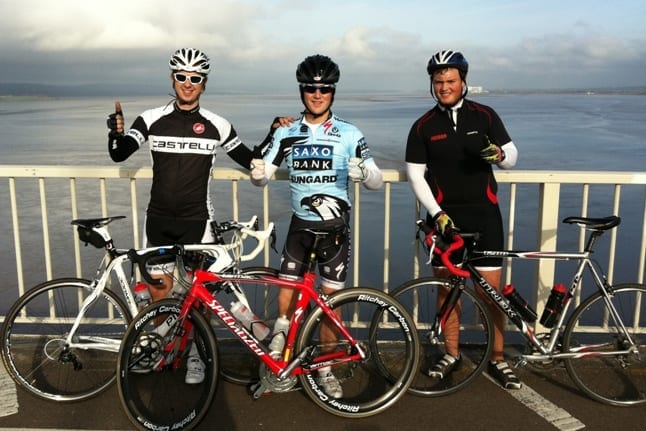Can you stop No-Stop now?
By TMX Archives on 16th Dec 11

The Stratford club recently ran a Centre trial under No Stop rules - and now genuinely see it as the way forward...
YOU can't beat a good long-running saga and in trials it doesn't get more long-running than the ‘Stop Allowed' or ‘No-Stop' observing debate. It is now a good 30 years since Bernie Schreiber, Eddy Lejeune, Gilles Burgat and co paved the way for the biggest upheaval in observed trials since the sport was first invented and the arguments have raged backwards and forwards ever since.
Time was when the only observing rule that counted was, did the machine cease forward motion. If it did then that was a five. Made no difference if the rider still had his feet on the pegs or was footing furiously. If that front wheel ceased to revolve the observer recorded a five. End of. No point disputing it. Riders did dispute it of course but the
observer's rule was still final.
Then the Continental riders ‘invented' a new way of riding at World Championship events. It really all started with American ace Bernie Schreiber and his pivot turns with the front wheel high in the air. This developed to momentary stops and front wheel hops, which then spread to rear wheel hops. Then, when the stop rule was adopted for World Championship events it really got radical. Riders could take five minutes to complete a section.
They used to do this on purpose so as to run their rivals out of time! An SWM factory rider called Giovanni Tosco parked-up in a section at the Italian World Round, back in 1981, and proceeded to chat away to his team manager and also to the observers who, gathering round Tosco, who was a very amusing man, all thought this was a huge joke while the riders losing time in the queue were going berserk...
I also once watched Donato Miglio park his factory Beta up in a section and change a broken throttle cable! This is absolutely true. His mechanic passed him the tools and parts. When the bike was once again a runner, Donato fired it up and received a clean for his troubles as he kept his feet on the pegs the whole time. We thought it all great fun at the time and pooh-poohed anyone who said that this wasn't trials. Time has proved us wrong I feel.
Being allowed to stop in a section, even reverse, was exciting and revolutionary but this meant that sections got ever more radical and difficult to mark out. Riders no longer looked at a section as a single obstacle to conquer. Each section was broken down into bike-sized pieces. Jump over a rock and stop. Re-position bike, rip up a step and stop. Repeat again and again until the Ends cards are reached. It is very technical and very skilful. But the fact is it actually took the dynamic of a section out of trials.
The thrill of watching a rider clean a section with a continuous ride, the applause reaching a crescendo as the Ends cards were approached was virtually gone forever. And how I remember the World Championship events when riders, who had taken forever to ride sections, ran out of time and were actually fighting to stick their front wheels into the final sections of the day to take a five and race back to the start to keep time penalties to a minimum.
All the above was probably, to a point, OK for World Championship trials which collectively tried desperately to stay abreast of the developments which were coming thick and fast. To keep events sort of on the move, section time limits were introduced, a set time for the first lap to be completed, the trials were shortened and run to a set format, etc, etc. Never underestimate the riders, introduce one rule and they soon find a loophole, which means that you need ANOTHER new rule. And so on.
And as we have seen, all the above, however well intentioned, has ultimately resulted in a dramatic drop in rider numbers, both at World and British levels. Which, strangely, isn't what this piece is about actually!
The problem comes when club, centre and even national events attempt to go back to No Stop rules. Riders still want to stop and mess around - and observers, who naturally don't seek confrontation, make allowances. This makes a mockery of the rules and it's a fact that some riders get away with murder.
The real point of this piece is that it doesn't have to be this way. In Trials Torque this week, the Stratford club's Alan Wright gives his summing-up of last Sunday's Ralph Varden trial which the club ran under No-Stop rules. Before the trial, riders were told in no uncertain terms what was expected of them - keep moving in the sections and NO arguing with the observer.
More importantly, observers were told to observe the rules to the letter. If a bike stops you give a five. And the club would be 100% behind the observers. On their part, the club ensured that the sections could all be ridden under No Stop rules. It was simply a case of setting strong ground rules from the start. One interesting thing was that the event atracted ten more riders than last year.
You can read the outcome yourself in TT on page 27...and you do need to really read the piece as Wrighty tells exactly WHY he decided to run the trial under No Stop rules... YOU can't beat a good long-running saga and in trials it doesn't get more long-running than the ‘Stop Allowed' or ‘No-Stop' observing
debate. It is now a good 30 years since Bernie Schreiber, Eddy Lejeune, Gilles Burgat and co paved the way for the biggest upheaval in observed trials since the sport was first invented and the arguments have raged backwards and forwards ever since.
Time was when the only
observing rule that counted was, did the machine cease forward motion. If it did then that was a five. Made no difference if the rider still had his feet on the pegs or was footing furiously. If that front wheel ceased to revolve the observer recorded a five. End of. No point disputing it. Riders did dispute it of course but the
observer's rule was still final.
Then the Continental riders ‘invented' a new way of riding at World Championship events. It really all started with American ace Bernie Schreiber and his pivot turns with the front wheel high in the air. This developed to momentary stops and front wheel hops, which then spread to rear wheel hops. Then, when the stop rule was adopted for World Championship events it really got radical. Riders could take five minutes to complete a section. They used to do this on purpose so as to run their rivals out of time! An SWM factory rider called Giovanni Tosco parked-up in a section at the Italian World Round, back in 1981, and proceeded to chat away to his team manager and also to the observers who, gathering round Tosco, who was a very amusing man, all thought this was a huge joke while the riders losing time in the queue were going berserk...
I also once watched Donato Miglio park his factory Beta up in a section and change a broken throttle cable! This is absolutely true. His mechanic passed him the tools and parts. When the bike was once again a runner, Donato fired it up and received a clean for his troubles as he kept his feet on the pegs the whole time. We thought it all great fun at the time and pooh-poohed anyone who said that this wasn't trials. Time has proved us wrong I feel.
Being allowed to stop in a section, even reverse, was exciting and revolutionary but this meant that sections got ever more radical and difficult to mark out. Riders no longer looked at a section as a single obstacle to conquer. Each section was broken down into bike-sized pieces. Jump over a rock and stop. Re-position bike, rip up a step and stop. Repeat again and again until the Ends cards are reached. It is very technical and very skilful. But the fact is it actually took the dynamic of a section out of trials. The thrill of watching a rider clean a section with a continuous ride, the applause reaching a crescendo as the Ends cards were approached was virtually gone forever. And how I remember the World Championship events when riders, who had taken forever to ride sections, ran out of time and were actually fighting to stick their front wheels into the final sections of the day to take a five and race back to the start to keep time penalties to a minimum.
All the above was probably, to a point, OK for World Championship trials which collectively tried desperately to stay abreast of the developments which were coming thick and fast. To keep events sort of on the move, section time limits were introduced, a set time for the first lap to be completed, the trials were shortened and run to a set format, etc, etc. Never underestimate the riders, introduce one rule and they soon find a loophole, which means that you need ANOTHER new rule. And so on.
And as we have seen, all the above, however well intentioned, has ultimately resulted in a dramatic drop in rider numbers, both at World and British levels. Which, strangely, isn't what this piece is about actually!
The problem comes when club, centre and even national events attempt to go back to No Stop rules. Riders still want to stop and mess around - and observers, who naturally don't seek confrontation, make allowances. This makes a mockery of the rules and it's a fact that some riders get away with murder.
The real point of this piece is that it doesn't have to be this way. In Trials Torque this week, the Stratford club's Alan Wright gives his summing-up of last Sunday's Ralph Varden trial which the club ran under No-Stop rules. Before the trial, riders were told in no uncertain terms what was expected of them - keep moving in the sections and NO arguing with the observer. More importantly, observers were told to observe the rules to the letter. If a bike stops you give a five. And the club would be 100% behind the observers. On their part, the club ensured that the sections could all be ridden under No Stop rules. It was simply a case of setting strong ground rules from the start. One interesting thing was that the event atracted ten more riders than last year.
You can read the outcome yourself in TT on page 27...and you do need to really read the piece as Wrighty tells exactly WHY he decided to run the trial under No Stop rules... YOU can't beat a good long-running saga and in trials it doesn't get more long-running than the ‘Stop Allowed' or ‘No-Stop' observing
debate. It is now a good 30 years since Bernie Schreiber, Eddy Lejeune, Gilles Burgat and co paved the way for the biggest upheaval in observed trials since the sport was first invented and the arguments have raged backwards and forwards ever since.
Time was when the only
observing rule that counted was, did the machine cease forward motion. If it did then that was a five. Made no difference if the rider still had his feet on the pegs or was footing furiously. If that front wheel ceased to revolve the observer recorded a five. End of. No point disputing it. Riders did dispute it of course but the
observer's rule was still final.
Then the Continental riders ‘invented' a new way of riding at World Championship events. It really all started with American ace Bernie Schreiber and his pivot turns with the front wheel high in the air. This developed to momentary stops and front wheel hops, which then spread to rear wheel hops. Then, when the stop rule was adopted for World Championship events it really got radical. Riders could take five minutes to complete a section. They used to do this on purpose so as to run their rivals out of time! An SWM factory rider called Giovanni Tosco parked-up in a section at the Italian World Round, back in 1981, and proceeded to chat away to his team manager and also to the observers who, gathering round Tosco, who was a very amusing man, all thought this was a huge joke while the riders losing time in the queue were going berserk...
I also once watched Donato Miglio park his factory Beta up in a section and change a broken throttle cable! This is absolutely true. His mechanic passed him the tools and parts. When the bike was once again a runner, Donato fired it up and received a clean for his troubles as he kept his feet on the pegs the whole time. We thought it all great fun at the time and pooh-poohed anyone who said that this wasn't trials. Time has proved us wrong I feel.
Being allowed to stop in a section, even reverse, was exciting and revolutionary but this meant that sections got ever more radical and difficult to mark out. Riders no longer looked at a section as a single obstacle to conquer. Each section was broken down into bike-sized pieces. Jump over a rock and stop. Re-position bike, rip up a step and stop. Repeat again and again until the Ends cards are reached. It is very technical and very skilful. But the fact is it actually took the dynamic of a section out of trials. The thrill of watching a rider clean a section with a continuous ride, the applause reaching a crescendo as the Ends cards were approached was virtually gone forever. And how I remember the World Championship events when riders, who had taken forever to ride sections, ran out of time and were actually fighting to stick their front wheels into the final sections of the day to take a five and race back to the start to keep time penalties to a minimum.
All the above was probably, to a point, OK for World Championship trials which collectively tried desperately to stay abreast of the developments which were coming thick and fast. To keep events sort of on the move, section time limits were introduced, a set time for the first lap to be completed, the trials were shortened and run to a set format, etc, etc. Never underestimate the riders, introduce one rule and they soon find a loophole, which means that you need ANOTHER new rule. And so on.
And as we have seen, all the above, however well intentioned, has ultimately resulted in a dramatic drop in rider numbers, both at World and British levels. Which, strangely, isn't what this piece is about actually!
The problem comes when club, centre and even national events attempt to go back to No Stop rules. Riders still want to stop and mess around - and observers, who naturally don't seek confrontation, make allowances. This makes a mockery of the rules and it's a fact that some riders get away with murder.
The real point of this piece is that it doesn't have to be this way. In Trials Torque this week, the Stratford club's Alan Wright gives his summing-up of last Sunday's Ralph Varden trial which the club ran under No-Stop rules. Before the trial, riders were told in no uncertain terms what was expected of them - keep moving in the sections and NO arguing with the observer. More importantly, observers were told to observe the rules to the letter. If a bike stops you give a five. And the club would be 100% behind the observers. On their part, the club ensured that the sections could all be ridden under No Stop rules. It was simply a case of setting strong ground rules from the start. One interesting thing was that the event atracted ten more riders than last year.
You can read the outcome yourself in TT on page 27...and you do need to really read the piece as Wrighty tells exactly WHY he decided to run the trial under No Stop rules... YOU can't beat a good long-running saga and in trials it doesn't get more long-running than the ‘Stop Allowed' or ‘No-Stop' observing
debate. It is now a good 30 years since Bernie Schreiber, Eddy Lejeune, Gilles Burgat and co paved the way for the biggest upheaval in observed trials since the sport was first invented and the arguments have raged backwards and forwards ever since.
Time was when the only
observing rule that counted was, did the machine cease forward motion. If it did then that was a five. Made no difference if the rider still had his feet on the pegs or was footing furiously. If that front wheel ceased to revolve the observer recorded a five. End of. No point disputing it. Riders did dispute it of course but the
observer's rule was still final.
Then the Continental riders ‘invented' a new way of riding at World Championship events. It really all started with American ace Bernie Schreiber and his pivot turns with the front wheel high in the air. This developed to momentary stops and front wheel hops, which then spread to rear wheel hops. Then, when the stop rule was adopted for World Championship events it really got radical. Riders could take five minutes to complete a section. They used to do this on purpose so as to run their rivals out of time! An SWM factory rider called Giovanni Tosco parked-up in a section at the Italian World Round, back in 1981, and proceeded to chat away to his team manager and also to the observers who, gathering round Tosco, who was a very amusing man, all thought this was a huge joke while the riders losing time in the queue were going berserk...
I also once watched Donato Miglio park his factory Beta up in a section and change a broken throttle cable! This is absolutely true. His mechanic passed him the tools and parts. When the bike was once again a runner, Donato fired it up and received a clean for his troubles as he kept his feet on the pegs the whole time. We thought it all great fun at the time and pooh-poohed anyone who said that this wasn't trials. Time has proved us wrong I feel.
Being allowed to stop in a section, even reverse, was exciting and revolutionary but this meant that sections got ever more radical and difficult to mark out. Riders no longer looked at a section as a single obstacle to conquer. Each section was broken down into bike-sized pieces. Jump over a rock and stop. Re-position bike, rip up a step and stop. Repeat again and again until the Ends cards are reached. It is very technical and very skilful. But the fact is it actually took the dynamic of a section out of trials. The thrill of watching a rider clean a section with a continuous ride, the applause reaching a crescendo as the Ends cards were approached was virtually gone forever. And how I remember the World Championship events when riders, who had taken forever to ride sections, ran out of time and were actually fighting to stick their front wheels into the final sections of the day to take a five and race back to the start to keep time penalties to a minimum.
All the above was probably, to a point, OK for World Championship trials which collectively tried desperately to stay abreast of the developments which were coming thick and fast. To keep events sort of on the move, section time limits were introduced, a set time for the first lap to be completed, the trials were shortened and run to a set format, etc, etc. Never underestimate the riders, introduce one rule and they soon find a loophole, which means that you need ANOTHER new rule. And so on.
And as we have seen, all the above, however well intentioned, has ultimately resulted in a dramatic drop in rider numbers, both at World and British levels. Which, strangely, isn't what this piece is about actually!
The problem comes when club, centre and even national events attempt to go back to No Stop rules. Riders still want to stop and mess around - and observers, who naturally don't seek confrontation, make allowances. This makes a mockery of the rules and it's a fact that some riders get away with murder.
The real point of this piece is that it doesn't have to be this way. In Trials Torque this week, the Stratford club's Alan Wright gives his summing-up of last Sunday's Ralph Varden trial which the club ran under No-Stop rules. Before the trial, riders were told in no uncertain terms what was expected of them - keep moving in the sections and NO arguing with the observer. More importantly, observers were told to observe the rules to the letter. If a bike stops you give a five. And the club would be 100% behind the observers. On their part, the club ensured that the sections could all be ridden under No Stop rules. It was simply a case of setting strong ground rules from the start. One interesting thing was that the event atracted ten more riders than last year.
You can read the outcome yourself in TT on page 27...and you do need to really read the piece as Wrighty tells exactly WHY he decided to run the trial under No Stop rules...


